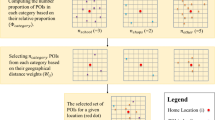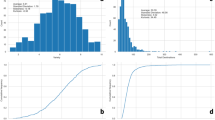Abstract
In this study, we measure jointly the labour and the residential accessibility of a basic spatial unit using a Bayesian Poisson gravity model with spatial effects. The accessibility measures are broken down into two components: the attractiveness component, which is related to its socio-economic and demographic characteristics, and the impedance component, which reflects the ease of communication within and between basic spatial units. For illustration purposes, the methodology is applied to a data set containing information about commuters from the Spanish region of Aragón. We identify the areas with better labour and residential accessibility, and we also analyse the attractiveness and the impedance components of a set of chosen localities which allows us to better understand their mobility patterns.










Similar content being viewed by others
Notes
We have used the geometric mean as reference for mathematical tractability reasons, because the components of the mean E[n ij ] = λ ij are expressed in Eq. (2) in an exponential way.
Given that the percentage of displacements eliminated was small, we assume that its impact in the final results was negligible.
Convergence was determined through visual inspection and using the Geweke (1992) diagnostic. The numerical Monte Carlo standard error (NSE) for all the parameters was <0.001, and the relative numerical efficiency (RNE) oscillated between 0.8645 and 1.0023.
An analysis using offset terms to adjust for size effects gave similar results, which have not been included by the sake of brevity.
The auto-contention of a place is the percentage of workers living and working in the same unit.
The values of w r (ν), m r (ν), \( s_{r}^{2} (\nu ) \) and R(ν) have been calculated from the MATLAB compute_mixture routine developed by Frühwirth-Schnatter et al. (2009).
References
Alonso W (1964) Location and land use: toward a general theory of land rent. Harvard University Press, Cambridge
Barrios MC, Godenau D, Schorn J (2009) Los mercados locales de trabajo y sus condiciones de accesibilidad en Tenerife. Boletín de la AGE 49:67–82
Batten DF, Boyce DE (1987) Spatial interaction: transportation and interregional commodity flow models. In: Nijkamp P (ed) Handbook of regional and urban economics, vol 1. North-Holland, Amsterdam, pp 357–406
Chakraborty A, Beamonte MA, Gelfand AE, Alonso MP, Gargallo P, Salvador M (2013) Spatial interaction models with individual-level data for explaining labor flows and developing local labor markets. Comput Stat Data Anal 58(1):292–307
Chun Y (2008) Modeling network autocorrelation within migration flows by eigenvector spatial filtering. J Geogr Syst 10(4):317–344
Chun Y, Griffith D (2011) Modeling network autocorrelation in space-time migration flow data: an eigenvector spatial filtering approach. Ann Assoc Am Geogr 101(3):523–536
Curry L (1972) Spatial analysis of gravity flows. Reg Stud 6(2):131–147
De Vries JJ, Nijkamp P, Rietveld P (2001) Alonso’s theory of movements: developments in spatial interaction modelling. J Geogr Syst 3(3):233–256
De Vries JJ, Nijkamp P, Rietveld P (2009) Exponential or power distance-decay for commuting? An alternative specification. Environ Plan A 41(2):461–480
El-Geneidy A, Levinson D (2011) Place rank: valuing spatial interactions. Netw Spat Econ 11(4):643–649
Fischer MM, Griffith D (2008) Modelling spatial autocorrelation in spatial interaction data: an application to patent data in the European Union. J Reg Sci 48(5):969–989
Flowerdew R, Aitkin M (1982) A method of fitting the gravity model based on the Poisson distribution. J Reg Sci 22(2):191–202
Flowerdew R, Lovett A (1988) Fitting constrained Poisson regression models to interurban migration flows. Geogr Anal 20(4):297–307
Fotheringham AS (1983) A new set of spatial-interaction models: the theory of competing destinations. Environ Plan A 15(1):15–36
Frühwirth-Schnatter S, Frühwirth R, Held L, Rue H (2009) Improved auxiliary mixture sampling for hierarchical models of non-gaussian data. Stat Comput 19(4):479–492
Geurs KTR, Ristsema VE (2001) Accessibity measures: review and applications. National Institute of Public Health and the Environment, Netherlands
Geweke J (1992) Evaluating the accuracy of sampling-based approaches to the calculation of posterior moments (with discussion). In: Bernardo J, Berger J, Dawid A, Smith A (eds) Bayesian statistics 4. Oxford Press, Oxford, pp 169–193
Griffith DA (2007) Spatial structure and spatial interaction: 25 years later. Rev Reg Stud 37(1):28–38
Griffith DA (2009a) Modeling spatial autocorrelation in spatial interaction data: empirical evidence from 2002 Germany journey-to-work flows. J Geogr Syst 11(2):117–140
Griffith DA (2009b) Spatial autocorrelation in spatial interaction. complexity-to-simplicity in journey-to-work flows. In: Reggiani A, Nijkamp P (eds) Complexity and spatial networks. Springer, Berlin, pp 221–237
Griffith DA, Fischer MM (2013) Constrained variants of the gravity model and spatial dependence: model specification and estimation issues. J Geogr Syst 15(3):291–317
Griffith DA, Jones KG (1980) Explorations into the relationship between spatial structure and spatial interaction. Environ Plan A 12(2):187–201
Hansen W (1959) How accessibility shapes land use. J Am Inst Plan 25(2):73–76
Heinzl H, Mittlböck M (2003) Pseudo R-squared measures for Poisson regression models with over- or under-dispersion. Comput Stat Data Anal 44(1–2):253–271
Hua CI (2001) Alonso’s systemic model: a review and representation. Int Reg Sci Rev 24(3):360–385
Ihlanfeldt KR, Sjoquist DL (1998) The spatial mismatch hypothesis: a review of recent studies and their implications for welfare reform. Hous Policy Debate 9(4):849–892
Kain JF (1992) The spatial mismatch hypothesis: three decades later. Hous Policy Debate 3(2):371–460
Kain JF (2004) A pioneer’s perspective on the spatial mismatch literature. Urban Stud 41(1):7–32
LeSage JP, Pace R (2008) Spatial econometric, modelling of origin–destination flows. J Reg Sci 48(5):941–967
LeSage JP, Fischer MM, Scherngell T (2007) Knowledge spillovers across Europe: evidence from a Poisson spatial interaction model with spatial effects. Pap Reg Sci 86(3):393–421
Reggiani A, Bucci P, Russo G (2011) Accessibility and impedance forms: empirical applications to the German commuting network. Int Reg Sci Rev 34(2):230–252
Roy JR, Thill JC (2004) Spatial interaction modelling. Pap Reg Sci 83(1):339–361
Sen A, Smith TE (1995) Gravity models of spatial interaction behaviour. Springer, Berlin
Spiegelhalter DJ, Best NG, Carlin BP, Van Der Linde A (2002) Bayesian measures of model complexity and fit. J R Stat Soc B 64(4):583–639
Tiefelsdorf M (2003) Misspecification in interaction model distance decay relations: a spatial structure effect. J Geogr Syst 5(1):25–50
Vickerman RW (1974) Accessibility, attraction and potential: a review of some concepts and their use in determining mobility. Environ Plan A 6(6):675–691
Wachs M, Kumagai T (1973) Physical accessibility as a social indicator. Socioecon Plan Sci 7(5):327–456
Wilson A (1970) Entropy in urban and regional modelling. Pion, London
Wilson A (1971) A family of spatial interaction models, and associated developments. Environ Plan A 3(1):1–32
Acknowledgments
The authors thank Professor Manfred Fischer and four reviewers for their comments and suggestions to earlier versions of the paper which helped to significantly improve its contents. Also appreciate the support of Professor Silvia Frühwirth-Schnatter. This research was partially supported by Grants CS02011-29943-C03-02 and ECO2012-35029 of the Spanish Ministry of Science and Innovation.
Author information
Authors and Affiliations
Corresponding author
Appendix
Appendix
This “Appendix” describes the algorithm used to calculate the posterior distribution of the parameters of model given by Eqs. (1)–(7) when f(t ij ; γ) = γg(t ij ) where, for instance, g(t ij ) = −t ij for the exponential model or g(t ij ) = − log(t ij + 1) for the power model. This algorithm is a modification of that proposed by LeSage et al. (2007) using the recent results of Frühwirth-Schnatter et al. (2009) that increases the efficiency of the estimation procedure. Details are as follows:
For each pair (i, j) \( \in \) {1, …, K} × {1, …, K}, we introduce the following latent variables:
As Frühwirth-Schnatter et al. (2009) showed, we have that:
To handle the above mixture, we introduce the indicators r ij,k \( \in \) {1, … ,R(ν ij , k )} in such a way that:
Based on these latent variables, the algorithm for calculating a sample of the posterior distribution of model parameters is as follows:
-
Step 0 Calculate the values of {R(ν ij,k ), w r (ν ij,k ), m r (ν ij, k ), \( s_{r}^{2} (\nu_{ij,k} ) \); r = 1, …, R(ν ij,k )}; k = 1, …, m ij ; i, j = 1, …, K.Footnote 6
-
Step 1 Obtain an initial sample of values of {τ ij,k, r ij,k ; k = 1, …, m ij ; i, j = 1, …, K} taking \( \lambda_{ij} = \left\{ {\begin{array}{ll} {0.1} \hfill & {{\text{if}}\,n_{ij} = 0} \hfill \\ {n_{ij} } \hfill & {{\text{if}}\,n_{ij} > 0} \hfill \\ \end{array} } \right. \) and using the full-conditional distributions described below.
-
Step 2 Implement Gibbs sampling using the full-conditional distributions given in LeSage et al. (2007) with the following modifications:
-
β|rest of the parameters; data
-
Let y ij,k = −log(τ ij,k ) − \( m_{{r_{ij,k} }} (\nu_{ij,k} ) \); k = 1, …, m ij and y ij = (y ij,k , k = 1, … ,m ij )′; i, j = 1, …, K.
We have then:
with ε ij ~ \( {\mathsf{\textit{N}}}_{{m_{ij} }} ({\mathbf{0}},{\text{diag(}}s_{{r_{ij,k} }}^{2} (\nu_{ij,k} ) ) ,k = 1, \ldots ,m_{ij} ) \) and \( {\mathbf{1}}_{{m_{ij} }} \) (m ij × 1) vector of ones.
We define:
and we have then:
with ε i ~ \( {\mathsf{\textit{N}}}_{{m_{i} }} (0,\varvec{S}_{{r_{i} }} ) \) where m i = m i1 + \( \cdots \) + m iK , \( S_{{r_{i} }} = {\text{diag(}}s_{{r_{ij,k} }}^{2} (\nu_{ij,k} );k = 1, \ldots ,m_{ij} ;j = 1, \ldots ,K ) \).
Hence, we obtain:
where
with m = m 1 + \( \cdots \) + m K and S r = \( {\text{diag(}}\varvec{S}_{{r_{1} }} , \ldots ,\varvec{S}_{{r_{K} }} ) \).
Therefore, it follows that:
where X = (1 m , X o , X d , g) and β = \( (\alpha ,\varvec{\beta}_{o}^{\prime } ,\varvec{\beta}_{d}^{\prime } ,\gamma )^{\prime } \)
Standard calculations show that:
-
\( (\tau_{ij,k} ;k = 1, \ldots ,m)|{\text{rest}}\,{\text{of}}\,{\text{the}}\,{\text{parameters}},\,{\text{data}} \)
-
$$ \begin{aligned} & {\text{If}}\,n_{ij} = 0\quad {\text{take}}\,\tau_{ij,1} = 1 + \xi_{ij} \,{\text{with}}\,\xi_{ij} \sim \text{Exp} (\lambda_{ij} ) \\ & {\text{If}}\,n_{ij} > 0\quad {\text{draw}}\,\xi_{ij} \sim \text{Exp} (\lambda_{ij} )\,{\text{and}}\,\tau_{ij,2} \sim {\text{Beta(}}n_{ij,1} )\,{\text{and}}\,{\text{take}}\,\tau_{ij,1} = 1 - \tau_{ij,2} + \xi_{ij} \\ \end{aligned} $$
-
-
\( r_{ij,1} ,r_{ij,2} |{\text{rest}}\,{\text{of}}\,{\text{the}}\,{\text{parameters}},\,{\text{data}} \)
Draw r ij,1 from the discrete distribution with support {1, …, R(ν ij,1)} and probability function:
where φ(x; m, s) denotes the value in x of the density function of a \( {\mathsf{\textit{N}}}(m,s) \).
If also n ij > 0, draw r ij,2 from the discrete distribution with support {1, …, R(ν ij,2)} and probability function:
Rights and permissions
About this article
Cite this article
Alonso, M.P., Beamonte, M.A., Gargallo, P. et al. Labour and residential accessibility: a Bayesian analysis based on Poisson gravity models with spatial effects. J Geogr Syst 16, 409–439 (2014). https://doi.org/10.1007/s10109-014-0201-3
Received:
Accepted:
Published:
Issue Date:
DOI: https://doi.org/10.1007/s10109-014-0201-3
Keywords
- Labour and residential accessibility
- Poisson gravity model
- Commuting
- Auxiliary mixture sampling
- Bayesian inference
- Spatial interaction models




